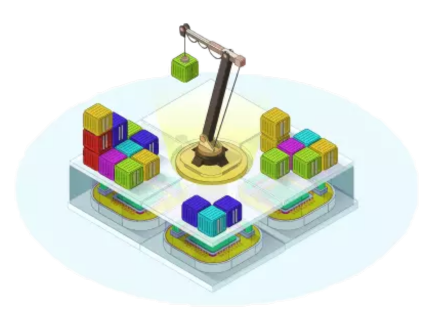What is container orchestration?
Container orchestration is not just a process; it is the engine that enables modern applications to run in complex environments such as the cloud. Imagine being able to deploy and manage thousands of containers in the blink of an eye, while ensuring optimal performance, near-total fault tolerance, and unlimited scalability.
This approach through platforms like AWS and Kubernetes also simplifies container management across different cloud services, providing accurate and reliable control. Read this article to learn why container orchestration is a must-have service for ambitious businesses today.

What is a container in the cloud?
A cloud container is a standardized deployment unit that encapsulates everything it takes to run an application. This process aggregates specific code, libraries, dependencies, and configurations, facilitating training and rapid deployment of services across heterogeneous environments. For example, a container instance can be run on different platforms like Kubernetes, Swarm or AWS without having to worry about differences in infrastructure.
Containers in the cloud are an ideal solution for deploying applications as continuous services. Encapsulating them allows the application to be independent of its environment, which promotes better portability between different systems, notably thanks to the efficiency of the network. The condition of containers is also a key element to monitor to ensure proper functioning.
Unlike virtual machines (VMs), which contain a full operating system, containers share the host kernel, making instances lighter, faster to boot, and more resource-efficient. This is especially true in AWS environments, where efficiency has a significant impact on the final cost of the service.
This allows more containers to be deployed on the same infrastructure, which is an advantage in cloud container environments. The container vs VM debate often arises in companies, but it is clear that each technology has its own advantages, depending on the type of applications and services used.
The use of containers ensures that applications run consistently, whether they are running locally, on-premises, or in the cloud. This allows services deployed via containers to be replicated and adjusted more quickly. This approach simplifies development efforts while reducing the risk of incompatibility for mission-critical applications.
◼ Containers are often grouped into units called pods. In Kubernetes, a pod is the smallest and simplest deployment object. It can contain one or more containers that share the same network and storage space, making them easier to communicate.
What are container orchestration platforms used for?
Using containers at scale requires orchestration tools that can manage hundreds or even thousands of containers across multiple servers or a cluster. These orchestration platforms perform several essential functions to ensure that each application and service runs efficiently and continuously:
- Deployment Automation - Container orchestration (via Kubernetes) enables containers to be automatically deployed across multiple nodes based on available resources and workload. This eliminates the need for manual, error-prone, and time-consuming deployment, by providing a fast, standardized set-up of production environments.
- Update and rollback management: you can deploy an update for your containerised services without causing any interruptions. This means your applications remain available in the cloud, even if there is a problem with an update. It can, for example, deploy a new version of an application on some of the containers in the cloud, and if anything goes wrong, roll back to the previous version without impacting users.
- Load balancing: Good load balancing management is essential to avoid overloads on a specific server. Orchestration platforms dynamically distribute load across containers, ensuring resources are used optimally.
- Fault Tolerance - If a server or container fails, the orchestrator automatically detects the problem and redeploys the failed container to another available node. This helps maintain a high level of availability, and ensures service continuity.
- Monitoring and maintenance: Orchestration tools provide monitoring capabilities that enable real-time tracking of container status. They can also detect anomalies and take appropriate action to prevent failures before they affect end users.
How does container orchestration work?
Container orchestration is based on automated processes and tools that manage how containers are distributed, monitored and maintained. It automatically determines the optimal container formation on a cluster, taking into account the capabilities of each node. This process ensures that CPU and memory resources are used efficiently for each instance deployed. Here are the main components of how orchestration works:
- Container scheduling: When an application is deployed, the orchestration tool decides which server or node each container should run on. This schedule takes into account available resources, such as CPU and memory capacity, and intelligently distributes containers to avoid overconsumption by a node.
- Automatic scaling: One of the most important benefits of orchestration is the ability to automatically adjust the number of containers as needed, in real time. If an application is experiencing a large increase in load, the orchestrator can instantly deploy new containers to absorb that load, and reduce them as demand decreases.
- Configuration and secret management: Containers often need to access sensitive data, such as database access credentials or API keys. Orchestration allows these secrets to be managed securely, ensuring they are only accessible to the containers concerned, without compromising security.
- Monitoring and automatic recovery: An important aspect of orchestration is constant container monitoring. If a container fails, it is automatically restarted or deployed to another node. This means your applications and services will always be available, no matter the circumstances.
- Network management: The orchestrator configures and manages communication between the different containers. It ensures that each container has a unique IP address and a secure private network, ensuring smooth communication between different parts of an application.
🔍 The microservices architecture is essential for modern applications. Micro services allow a complex application to be broken down into a number of independent services. Each service can be developed, deployed and managed separately.
Orchestration tools
There are several container orchestration tools. Each tool has its own advantages. Some of the most popular are Kubernetes and Docker Swarm. These solutions are commonly used in cloud environments to manage containerised infrastructure.
Kubernetes
Kubernetes, often abbreviated to K8s, is probably the most popular container orchestration tool in the world. It was developed by Google and is now an open-source project maintained by the Cloud Native Computing Foundation (CNCF). Kubernetes is particularly well-suited to managing large containerised infrastructure spread across hundreds or even thousands of nodes. Its main features include:
Automatic scaling
Kubernetes can adjust the number of containers based on network load or user demand. This means you can adapt to traffic fluctuations without manual intervention.
Fault Tolerance
In the event of container or node failure, Kubernetes automatically restarts the affected containers on other nodes, ensuring greater resilience for your applications and service to your customers.
Continuous update
With Kubernetes, you can deploy software updates gradually, without interrupting the service for users. If anything goes wrong, it can also quickly roll back to the previous version.
◼ Although less well-known than Kubernetes or OpenShift, Mesos is a powerful solution used by some companies to manage a container cluster on a large scale.
Docker Swarm
Docker Swarm is another orchestration solution, which is part of the Docker ecosystem. Unlike Kubernetes, Docker Swarm is easier to configure, making it an ideal choice for smaller teams or smaller deployments. Its main features include:
Native Docker integration
Docker Swarm is integrated directly into Docker, making it easy for developers already familiar with the Docker environment to get started.
Simplicity
Docker Swarm is easier to use than Kubernetes. Although its orchestration features are less advanced, Docker Swarm is more than sufficient for many use cases, including test environments or small infrastructure.
OVHcloud orchestration solutions
OVHcloud offers a full range of orchestration solutions suitable for companies that use containers in the cloud. These solutions are integrated with OVH’s public cloud offering, and enable customers to easily deploy and manage containerised applications at scale.
OVHcloud is compatible with open-source technologies such as Kubernetes, allowing users to enjoy the benefits of Kubernetes, while also enjoying OVHcloud’s reliable and secure infrastructure. Here are some of the key features of OVHcloud orchestration solutions:
Flexibility
OVHcloud offers scalable and modular infrastructure, which adapt to customer needs, whether they are small applications or large distributed projects requiring large-scale orchestration on a Kubernetes cluster.
Integration with Kubernetes
One of the advantages of OVHcloud is that it offers simplified management for each Kubernetes cluster. Our users can easily create, monitor and manage each cluster they work with.
Security
As a major player in the European cloud industry, OVHcloud offers customers enhanced security, with infrastructure that are compliant with European regulations, such as the GDPR. This ensures that sensitive customer data is protected at every stage of the orchestration process.
OVHcloud and container orchestration

Container orchestration has become indispensable for companies that want to innovate quickly while ensuring the stability of their services. OVHcloud, with its advanced cloud services, enables businesses to benefit from simplified container management with powerful tools like Kubernetes.
Businesses looking to manage real-time data pipelines, process massive volumes of data, or implement streaming solutions will find OVHcloud a reliable platform, optimized for these needs. OVHcloud’s infrastructure offers smooth and secure container management, making it easy to integrate and rapidly deploy applications across the globe.
For those who want to learn more, discover the OVH cloud containers, an ideal solution for orchestrating your applications in a modern, flexible and scalable cloud environment.